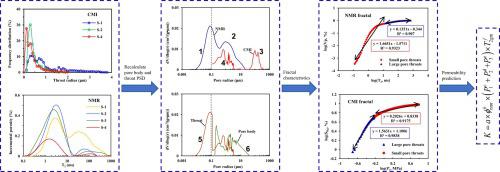Journal of Asian Earth Sciences ( IF 2.7 ) Pub Date : 2021-03-18 , DOI: 10.1016/j.jseaes.2021.104739 Ren-Shi Nie , Jie Zhou , Zhangxin Chen , Jingcheng Liu , Yi Pan

|
Pore structure characterization is a very crucial work to understand rock properties. In this work, a novel integrated method was proposed to characterize the pore structure of a real tight sandstone reservoir in the Sulige gas field. This integrated method requires a comprehensive analysis of experimental results based on cast thin section (CTS), nuclear magnetic resonance (NMR), constant-rate mercury intrusion (CMI) and X-ray computed tomography (XCT) techniques. Five main pore types were firstly identified from CTS images. Bimodal distribution curve of surface relaxivity rate, mercury injection curves of pore body and throat, 3D visual image of pore reconstruction were then generated from NMR, CMI and XCT measurements, respectively. Pore size distribution (PSD) was also obtained by and compared among NMR, CMI and XCT techniques. Full size PSDs of pore body and throat were ultimately determined using a combination analysis method of NMR and CMI. In addition, fractal dimension was calculated by NMR- and CMI-deduced formulas. Moreover, pores were classified into three categories and the contribution of different category pore to rock properties was qualitatively ascertained. At the end, a novel permeability prediction model in consideration of the contributions of three category pore was established. It was found that radii of pore body and throat ranged in 0.21–42.01 μm and 0.006–3.7 μm, respectively. Sandstone pore has multifractal characteristics and its fractal dimension ranged in 1.335–2.982. Overall, sandstone pore structure of the example reservoir was characterized by multiple pore types, nano-micrometer pore scale, irregular geometric shape, non-uniform distribution, poor connection status and bad development degree of pore space. The findings of this study can help for better understanding of pore structure characteristics of tight sandstones.
中文翻译:

新型集成方法表征致密砂岩孔隙结构特征-以鄂尔多斯盆地苏里格气田为例
孔结构表征是了解岩石性质的一项非常关键的工作。在这项工作中,提出了一种新颖的综合方法来描述苏里格气田中一个真正的致密砂岩储层的孔隙结构。这种集成方法需要基于铸造薄截面(CTS),核磁共振(NMR),恒速汞侵入(CMI)和X射线计算机断层扫描(XCT)技术对实验结果进行全面分析。首先从CTS图像中识别出五种主要的孔类型。然后分别通过NMR,CMI和XCT测量生成了表面弛豫率的双峰分布曲线,孔体和喉部的汞注入曲线,孔重建的3D视觉图像。孔径大小分布(PSD)也可以通过NMR,CMI和XCT技术获得并进行比较。最终使用NMR和CMI的组合分析方法确定了孔体和喉部的全尺寸PSD。此外,分形维数是根据NMR和CMI推导的公式计算的。此外,将孔隙分为三类,并定性确定了不同类别的孔隙对岩石性质的贡献。最后,建立了考虑三类孔隙贡献的新型渗透率预测模型。发现孔体半径和喉部半径分别在0.21–42.01μm和0.006–3.7μm之间。砂岩孔隙具有多重分形特征,其分形维数范围为1.335-2.982。总体而言,示例储层的砂岩孔隙结构具有多种孔隙类型,纳米微米的孔隙规模,不规则的几何形状,分布不均匀,连接状态差,孔隙空间发展程度差。这项研究的发现有助于更好地理解致密砂岩的孔隙结构特征。











































 京公网安备 11010802027423号
京公网安备 11010802027423号